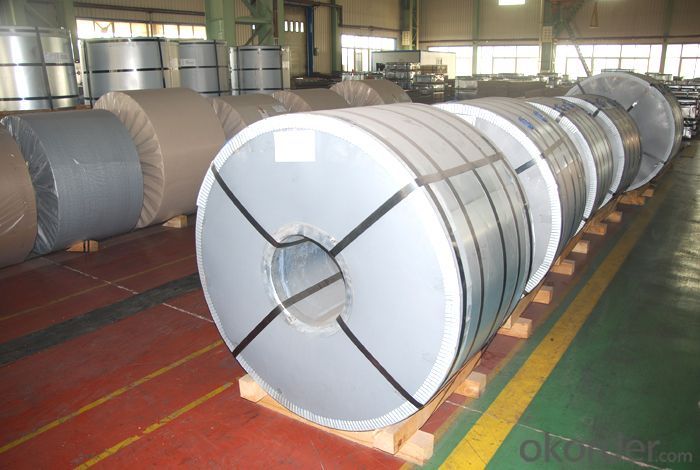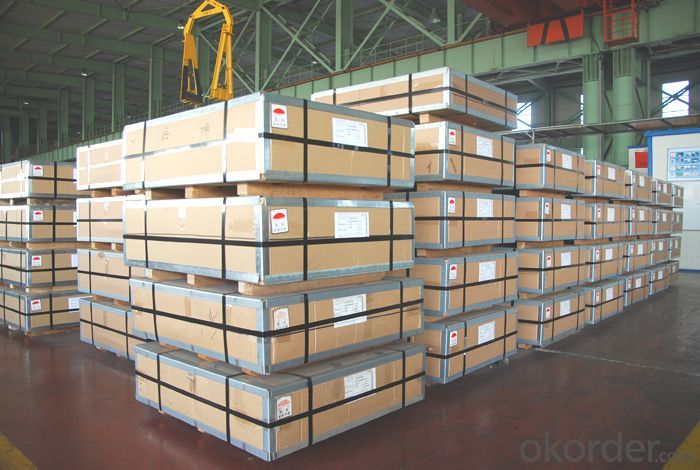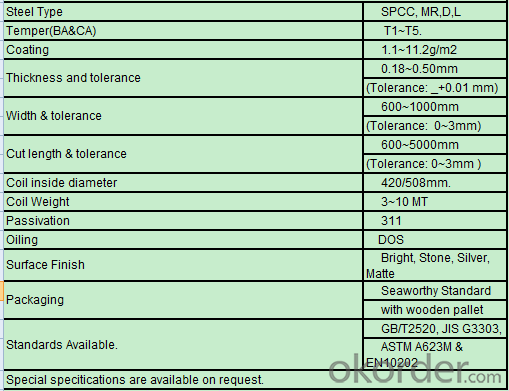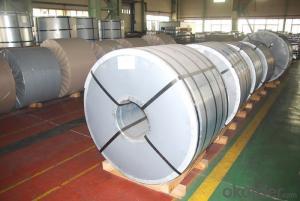Lacquered Tinplate for Metal Packing ETP Coils
- Loading Port:
- Shanghai
- Payment Terms:
- TT OR LC
- Min Order Qty:
- 100 m.t.
- Supply Capability:
- 40000 m.t./month
OKorder Service Pledge
OKorder Financial Service
You Might Also Like
We manufactures and sales Electrolytic Tinplate (ETP) and provides the lithography service for its domestic and international clients, guaranteeing quality, timely deliveries and offering technical assistance with the purpose of providing our clients added value with our products. We provide technical assistance and contribute in special projects made with our indirect clients to develop the market of our direct clients.
Tinplate (TP) is a heterogeneous material of stratified structure known like electrolytic tinplate (TP), whose base is made by a sheet of sweet steel of low carbon, covered by both faces by a cap of tin, which is used to manufacture tin cans and tin can parts, which must comply certain properties according to the product to be canned, the process of production and the final destination of the canned product.
Electrolytic TinPlate: Composition
E.T.P. consists of five layers each of which performs a different role:
1. Steel Base: Provides stiffness to the material due to its thickness and mechanical strength. Its chemical composition imparts special properties to resist corrosion.
2. Iron-Tin Alloy: This is made up by the inter-metallic compound Fe-Sn2. Due to its electrochemical characteristics, it acts as a barrier against corrosion. For effective action, its continuity is more important than its quantity.
3. Metallic Tin: Tin has many advantages which have turned it into the most important element to protect steel used for cans; in many foods, it acts as a simple barrier against corrosion, improves weldability, it is an excellent base for lithographic printing and for applying lacquers. In tin-robbing foods, it acts as a sacrificial element.
4. Passivation Film: According to its nature, it makes it possible to improve the E.T.P.’s resistance to sulphiding, oxidation and rust. It is also a conditioner to improve the adherence of varnishes, inks, lacquers etc.
5. Oil Film: Protects the sheet from the humidity in the environment and makes easy to handle. It is applied using an electrostatic oiler on both sides of the sheet.
Main Features of the Lacquered Tinplate for Metal Packing ETP Coils
Tinplate can ensure food hygiene and minimize the possibility of corruption, effectively
prevent the danger to health, but also in line with modern convenience in tinplate packaging
of canned food diet, rapid demand, tea packaging, coffee packaging, health careproduct
packaging, candy wrappers, cigarette packaging, gift packaging, food packaging containers
are preferred.As well as other miscellaneous cans of the oils and fats cans, chemicals
cans, beverage cans, spray cans, and and so on on.
Lacquered Tinplate for Metal Packing ETP Coils Images



Lacquered Tinplate for Metal Packing ETP Coils Specification

FAQ of Prime 2.8/2.8 EPT Sheets Coils TinPlate For Cans Making
How long does it take to get the product if i place an order?
With the process of your requirements,we will pack and deliver in 3-7 days.If it is by sea shipment,it will take 15-45 days depending on different locations.
- Q:What is the shelf life of tinplate?
- The shelf life of tinplate can vary depending on various factors such as storage conditions and the presence of any protective coatings. However, tinplate typically has a long shelf life, often lasting several years or more if stored properly in a cool, dry place.
- Q:Can tinplate be welded or soldered?
- Yes, tinplate can be both welded and soldered. Welding involves fusing two pieces of metal together using heat, while soldering involves joining metal components using a lower melting point filler material called solder. Tinplate, which is a thin sheet of steel coated with a layer of tin, can undergo these processes with appropriate techniques and materials.
- Q:What are the different types of tinplate containers available?
- There are several different types of tinplate containers available, including cans, tins, boxes, and drums. These containers can vary in size, shape, and functionality, and are commonly used for packaging food, beverages, chemicals, and other products.
- Q:What are the main applications of tinplate in the gardening industry?
- Tinplate is commonly used in the gardening industry for various applications such as plant pots, seed trays, watering cans, and garden tools. The use of tinplate ensures durability, corrosion resistance, and ease of maintenance, making it an ideal choice for these gardening essentials. Additionally, tinplate can also be utilized for packaging purposes, such as cans for storing fertilizers, pesticides, and other gardening products.
- Q:How do you clean the dust and trace oil on tin containers?
- Water based cleaning method: that is, with clean water and cleaning agent to remove oil method, the use of water washing process. This process started relatively late in the country, and the technical strength of various manufacturers formula is uneven, of which the more representative of public praise is "evergreen peak" brand CLF water-based cleaning agent series.
- Q:How does tinplate compare to stainless steel in terms of properties and applications?
- Tinplate and stainless steel have different properties and applications. Tinplate is a steel coated with a thin layer of tin, providing corrosion resistance and a shiny appearance. It is commonly used for packaging food and beverages, as it is lightweight and easily formed into cans. On the other hand, stainless steel is an alloy with high corrosion resistance and strength. It is widely used in various industries, including construction, automotive, and kitchen appliances, due to its durability and aesthetic appeal. While both materials offer corrosion resistance, stainless steel is generally stronger and more versatile, making it suitable for a wider range of applications compared to tinplate.
- Q:Can tinplate be used for coinage?
- No, tinplate cannot be used for coinage as it is a thin sheet of steel coated with a layer of tin, which is not a suitable material for making coins.
- Q:How does tinplate perform in terms of temperature resistance?
- Tinplate has good temperature resistance, as it can withstand both high and low temperatures without significant deformation or degradation.
- Q:What is the cost of tinplate compared to other packaging materials?
- The cost of tinplate is generally higher compared to other packaging materials such as aluminum, paper, or plastic. Tinplate is a durable and versatile material, but its higher cost is primarily due to the production process involving coating steel with a thin layer of tin. While other materials may offer a more cost-effective solution for certain applications, tinplate's unique properties and premium image make it a preferred choice for certain industries like food and beverages, cosmetics, and pharmaceuticals. Ultimately, the cost of tinplate should be evaluated in relation to the specific needs and requirements of the packaging project.
- Q:What are the disadvantages of using tinplate?
- One disadvantage of using tinplate is its relatively high cost compared to other materials. Additionally, tinplate can be prone to corrosion if not properly coated or maintained. It is also less flexible than some alternative materials, making it less suitable for certain applications. Lastly, tinplate can be challenging to recycle due to the complexity of separating the tin coating from the steel, which can contribute to environmental concerns.
1. Manufacturer Overview |
|
|---|---|
| Location | |
| Year Established | |
| Annual Output Value | |
| Main Markets | |
| Company Certifications | |
2. Manufacturer Certificates |
|
|---|---|
| a) Certification Name | |
| Range | |
| Reference | |
| Validity Period | |
3. Manufacturer Capability |
|
|---|---|
| a)Trade Capacity | |
| Nearest Port | |
| Export Percentage | |
| No.of Employees in Trade Department | |
| Language Spoken: | |
| b)Factory Information | |
| Factory Size: | |
| No. of Production Lines | |
| Contract Manufacturing | |
| Product Price Range | |
Send your message to us
Lacquered Tinplate for Metal Packing ETP Coils
- Loading Port:
- Shanghai
- Payment Terms:
- TT OR LC
- Min Order Qty:
- 100 m.t.
- Supply Capability:
- 40000 m.t./month
OKorder Service Pledge
OKorder Financial Service
Similar products
New products
Hot products
Hot Searches
Related keywords


























